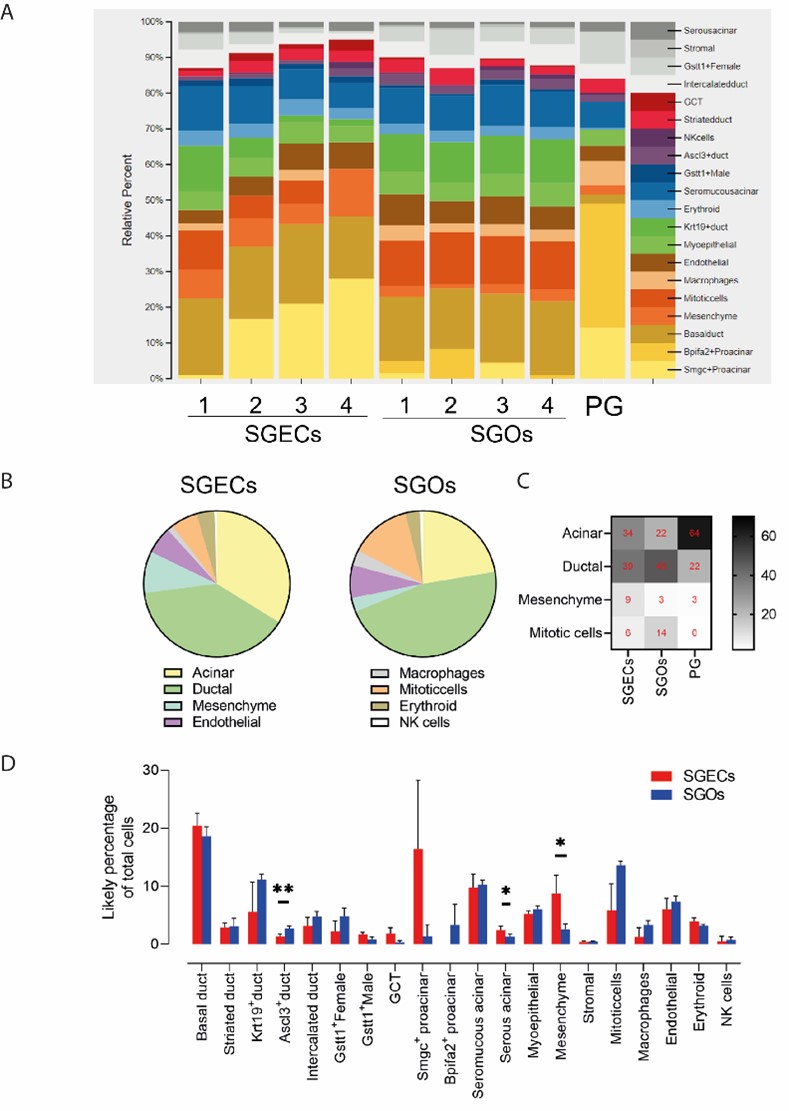Session Information
Session Type: Poster Session B
Session Time: 10:30AM-12:30PM
Background/Purpose: The majority of the critical pieces of work probing the involvement of the salivary gland (SG) epithelium in Sjogren’s Disease (SjD) employ salivary gland epithelial cell cultures (SGECs) presumed to recapitulate the involvement of the striated ducts in disease pathology. In recent years, organoid technology has offered a more advanced model system for studying epithelial cells in health and disease. Organoids are widely believed to accurately mimic the organization and structure of the organ from which they are derived. Organoids from the salivary gland have been described and employed in the study of SG pathology in SjD1. We aim to investigate cells types contained in adherent SGECs and 3-dimensional SG organoid (SGO) cultures.
Methods: Matched SGEC and SGO cultures were derived from healthy parotid SGs. Bulk RNA sequencing analysis and deconvolution was performed.
Results: No striking difference in SG ductal, acinar or myoepithelial marker gene expression between SGECs and SGOs was observed. Extracellular matrix organization pathways were highly expressed in SGEC cultures, and epithelial development pathways in SGOs. Mesenchymal marker genes, including CD90, COL15A1, COL1A2, and DCN, were significantly higher expressed in SGEC cultures. Deconvolution suggested that SGECs and SGOs are heterogeneous cultures, both containing basal, striated, Krt19+ ductal, Ascl3+ ductal, intercalated, Gstt1+ male and female, and granulated convoluted tubule ductal cells (Figure 1). SGO cultures contain slightly more total ductal cells (46%) compared to SGECs (39%) (Figure 1). SGECs and SGOs both contain seromucous, mucous and Smgc+ acinar cells. SGOs also contained Bpifa2+ acinar cells. Mesenchymal cells likely comprise 10% of SGEC cultures, compared to 3% in SGOs (Figure 1).
Conclusion: SGECs and SGO cultures are heterogenous in nature. SGOs contain more epithelial cell types and a higher proportion of ductal cells. In contrast, mesenchymal cells comprise a larger proportion of SGECs.
To cite this abstract in AMA style:
Yang T, Soto Gamez A, Terpstra J, Bootsma H, Vissink A, Kroese F, Pringle S. Salivary Organoids Contain More Diverse Epithelial and Less Mesenchymal Cells Than Adherent Cultures: Choose Your Sjögren’s Disease Research Tool Carefully [abstract]. Arthritis Rheumatol. 2024; 76 (suppl 9). https://acrabstracts.org/abstract/salivary-organoids-contain-more-diverse-epithelial-and-less-mesenchymal-cells-than-adherent-cultures-choose-your-sjogrens-disease-research-tool-carefully/. Accessed .« Back to ACR Convergence 2024
ACR Meeting Abstracts - https://acrabstracts.org/abstract/salivary-organoids-contain-more-diverse-epithelial-and-less-mesenchymal-cells-than-adherent-cultures-choose-your-sjogrens-disease-research-tool-carefully/

